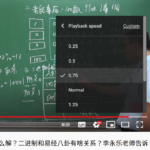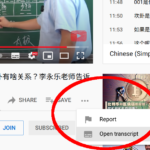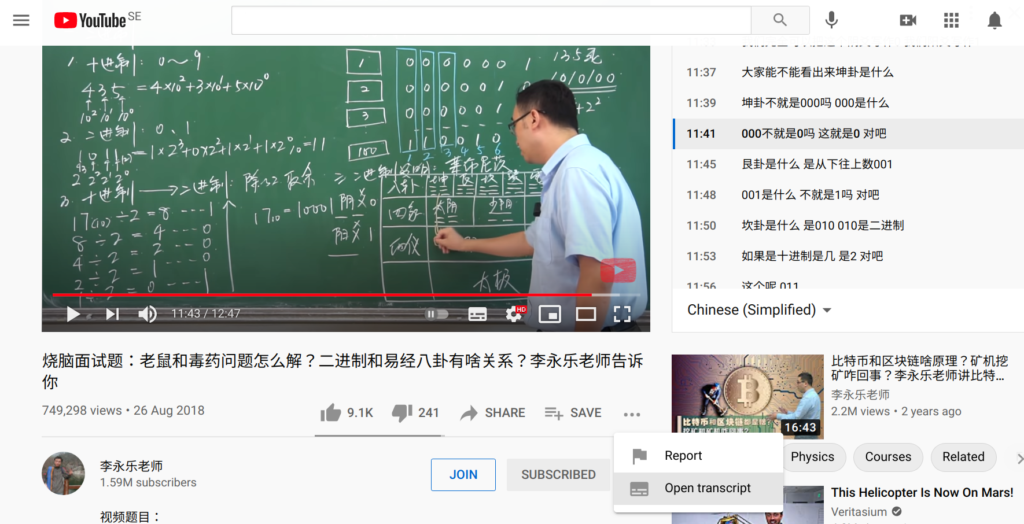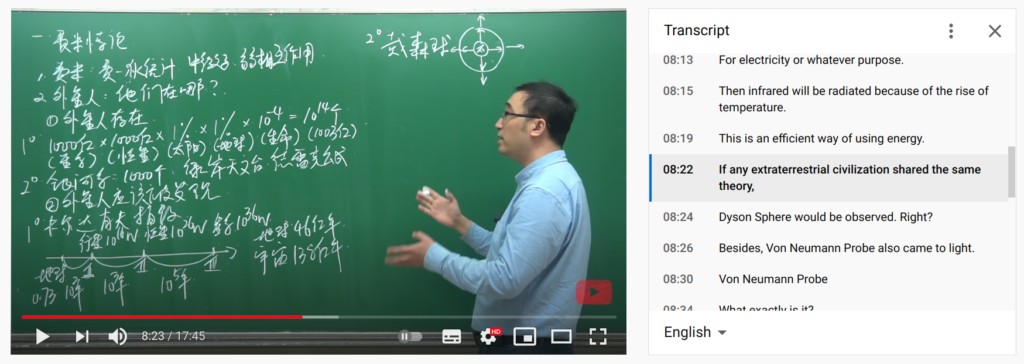I started learning Chinese with university courses designed for students in international programs focusing on industrial engineering and management, and applied physics and electrical engineering. While I choose to focus on language and teaching after that, I’ve always felt attracted to the natural sciences. Today, I also teach Chinese courses for students in these very same programs.
Learning science in Chinese is similar to learning the language for other special purposes. For beginners, it’s the same as learning the language in general, except you go easy on things that are peripheral to your primary goal, such as sports, cuisine and so on. Instead, you add in basic mathematics and other things necessary to even begin making sense of texts about more complicated topics.
Tune in to the Hacking Chinese Podcast to listen to the related episode:
Available on Apple Podcasts, Google Podcast, Overcast, Spotify and many other platforms!
More advanced students can read texts focusing on science without too much problem as long as they are familiar with the underlying concepts and the texts have been adapted a bit. This is a case of learning language through content, rather than learning something new through a new language, which is much harder. In contrast to what most people think, scientific writing us considerably easier than reading literature.
Learning science in Chinese with 李永乐老师
One way of becoming literate or conversant in a certain area of Chinese is to follow the path of native speakers. Do you want to learn about literature? Check middle-school textbooks for Chinese students (I wrote about that here: The benefits of using 语文/國文 textbooks to learn Chinese). Do you want to be able to talk about geography in Chinese? Get hold of a textbook for native speakers. If you want to try this out, I introduced a resource with a large number of textbooks here:
One thing you can’t get through textbooks, no matter how good, is the immersive experience you get in a real classroom. Thanks to the internet and the huge appetite for educational material online, you can actually achieve this in other ways, though, without leaving the comfort of your home!
李永乐老师 (Lǐ Yǒnglè lǎoshī) is a great example of this. He’s a science teacher at a prestigious school in Beijing, but also has a popular channel on YouTube (1.6 million subscribers) and 西瓜视频 (13 million fans). To date, he has published almost 400 videos, mostly dealing with mathematics and the natural sciences, but also other topics such as finance, biology and statistics. Most of these are available for free.
Three examples of learning science in Chinese with 李永乐老师
Before you dive in, there are a couple of things to note.
- The content is not easy. If you’ve been sticking with normal textbooks, you probably don’t have the vocabulary necessary to stand much of a chance here. Beginners should ignore this resource completely and focus on listening practice more suitable for beginners.
- He talks really fast. While I believe that 李永乐老师 is a very good teacher, he talks way too fast, at least 50% faster than would make sense in this context. Unless you have a serious amount of listening under your belt, it’s unlikely you’ll understand much without support. It should be mentioned that while he talks fast, his pronunciation is clear.
- His handwriting is not easy to read. Unless you’ve spent a lot of time reading handwritten Chinese characters, it’s probable that you understand nothing of what he writes on the board (read more here: Learning to read handwritten Chinese). Still, he draws and shows many other things, and there are subtitles to make it easier. More about that later!
After I show you three sample videos, I will introduce tips and tricks to incorporate these types of videos in your learning, even if your listening ability doesn’t allow you to dive straight in. These are not specific to these videos, of course, but are extra useful when the content is difficult.
Here are three videos from 李永乐老师 that I like:
1. 外星人存在吗?人类为什么看不到外星文明?李永乐老师讲费米悖论
English title: Does aliens exist? Why don’t we see alien civilization? Mr. Li talks about Fermi’s paradox
This video is about the Fermi Paradox, or in other words, the contradiction between the size of the universe and the number of worlds that could host life, and the apparent lack of alien civilisations, also known as “where are all the aliens?” In this video, he manages to cover a lot of ground in a reasonably short time, without skipping too much. Of course, there’s more to say about every part of this video, but for the casual viewer, this is a great summary! For those who want more (in English), check this series on YouTube.
2. 我们为啥摆脱不了贫穷?穷人富人有啥差别?诺贝尔经济学奖解读
English title: How to break away from poverty? 2019 Nobel Economics Prize explained
This is an explanation of the 2019 Nobel Prize in economics, which was awarded to Banerjee, Duflo and Kremer “for their experimental approach to alleviating global poverty”. Here we can se another aspect I like with 李永乐老师: he starts from basic principles and builds up the understanding that is needed for to answer the question. When watching his videos, I seldom feel he skips important things or dwells too long on uninteresting details. While I’m not a science teacher, I know good teaching when I see it.
3. 烧脑面试题:老鼠和毒药问题怎么解?二进制和易经八卦有啥关系?李永乐老师告诉你
English title (my translation): Brainy interview question: How to solve the rats and poison problem, and What’s the relationship between binary numbers and the eight trigrams of the Yìjīng (Book of Changes)?
This video covers the basics of the binary number system, and is a good example of why I think he’s a good teacher. Not only are the concepts clearly explained, but he also adds his own touch, linking it up with the numerology of the Chinese classic 易经 (Yìjīng), Book of Changes. I actually knew about this potential connection before I watched the video, because I knew about Leibnitz’ interest in the 易经 (Yìjīng). However, he ends up dismissing the connection as it seem the causality ran the other way around (Leibnitz learnt about 易经 (Yìjīng) too late for it to have had an influence on his work with binary numbers. You need to be very well-read indeed to not learn something from his videos.
How to learn science Chinese from 李永乐老师
Most readers who checked any of the videos above probably feel daunted by the rate of speech and the amount of vocabulary thrown your way. Granted, if you’re a beginner, this is clearly not for you (I hope that was clear from the beginning), but if you’re intermediate or advanced learner, you can make sense of these videos!
Most of you probably can’t just listen to them while jogging and get something out of it, but with the right scaffolding, these videos can be really good for learning. Let’s have a look at how to make them comprehensible:
 Know roughly what he’s talking about before you start – Learning Chinese by studying something you’re already familiar with in your native language, but now doing it in Chinese, is great. It’s a little bit like reading a translation of a novel you already know and love to ease yourself into reading novels in Chinese. Learning something you have no clue about in your native language in Chinese is an order of magnitude harder. Thus, choose videos about topics you’re already interested in and know fairly well. If you don’t know what a binary number is, stay away from the third sample above, unless your Chinese is already very good.
Know roughly what he’s talking about before you start – Learning Chinese by studying something you’re already familiar with in your native language, but now doing it in Chinese, is great. It’s a little bit like reading a translation of a novel you already know and love to ease yourself into reading novels in Chinese. Learning something you have no clue about in your native language in Chinese is an order of magnitude harder. Thus, choose videos about topics you’re already interested in and know fairly well. If you don’t know what a binary number is, stay away from the third sample above, unless your Chinese is already very good.- Listen more than once – This is so obvious that I hesitate to mention it, but your ability to process spoken language is limited, and when it comes to a second language, it’s limited to the point that you’re unlikely to be able to process most of what he says. By listening more than once, you gradually free up resources to deal with more and more of the content, until you run into other things blocking your understanding, such as a lack of vocabulary. Reaching this point can take dozens of listens.
- Watch and listen – The spoken presentation in these videos is directly supported by what’s shown on screen. If you don’t feel up to it, just ignore his handwriting and focus on drawings, diagrams, numbers and other things that aren’t Chinese characters. In some videos, this can help understanding immensely. For example, in the sample video about binary numbers, most of what you need is actually written with Arabic numerals.
 Slow down the speed – YouTube offers a slow-down function; just click the cogwheel below the video and select “playback speed”. Setting it to 0.75 is reasonable and the quality is still quite good. If you go lower than that, the audio starts breaking up too much. Slowing down audio like this gives you more time to parse the incoming sound stream while still retaining all the characteristics of connected speech (compare with teacher talk or textbook recordings, which are spoken slowly and deliberately, and thus do not retain some of the characteristics of natural speech).
Slow down the speed – YouTube offers a slow-down function; just click the cogwheel below the video and select “playback speed”. Setting it to 0.75 is reasonable and the quality is still quite good. If you go lower than that, the audio starts breaking up too much. Slowing down audio like this gives you more time to parse the incoming sound stream while still retaining all the characteristics of connected speech (compare with teacher talk or textbook recordings, which are spoken slowly and deliberately, and thus do not retain some of the characteristics of natural speech). Enable subtitles – 李永乐老师’s videos come with subtitles in simplified Chinese (see the next point if you want traditional). These are displayed on screen and are easy to read, in contrast to the writing on the blackboard. This also allows you to pause, go back and read what he says, making it much more likely that you understand. Naturally, it takes a while to work you way through a videos this way, but it’s great if you struggle to hear a specific word. However, I normally suggest that you listen before you read.
Enable subtitles – 李永乐老师’s videos come with subtitles in simplified Chinese (see the next point if you want traditional). These are displayed on screen and are easy to read, in contrast to the writing on the blackboard. This also allows you to pause, go back and read what he says, making it much more likely that you understand. Naturally, it takes a while to work you way through a videos this way, but it’s great if you struggle to hear a specific word. However, I normally suggest that you listen before you read. Read the transcript – On YouTube, you can show the transcript by clicking the three dots on the far right below the video, then selecting “open transcript”. This gives you a text version of the whole video, with time stamps. You can treat this as any text you want to study, but of course be aware that the source is spoken Chinese and that what sounds normal might not look normal when written down. If you struggle with understanding the spoken version but are good at reading, reading through it once before listening can be very helpful.
Read the transcript – On YouTube, you can show the transcript by clicking the three dots on the far right below the video, then selecting “open transcript”. This gives you a text version of the whole video, with time stamps. You can treat this as any text you want to study, but of course be aware that the source is spoken Chinese and that what sounds normal might not look normal when written down. If you struggle with understanding the spoken version but are good at reading, reading through it once before listening can be very helpful.- Check the translation – Some of the videos have an English transcript (most have simplified and traditional Chinese), which is probably machine translated. While I haven’t read through many of these to check the quality, those that I did check (such as the Fermi Paradox video) were quite good, definitely enough to understand the point in most cases. Don’t get hung up on details here, though; if something doesn’t make sense in English, it’s probably just a bad translation.
- Download the audio for reviewing later – There are numerous ways to download just the audio from YouTube, but since I’m not sure about the legal status of these, I won’t link to a specific tool. If your listening ability is good (near-native), you can just listen to most of his lessons as they very rarely rely on things shown in the video. If your listening ability is not that good yet, you can still download the audio and put it on your phone to review later.
- Try out Language Learning with Youtube (beta) – This plugin for Chrome combines many of the steps above to create a better learning experience. For example, it can show you subtitles in two languages at once and has a built-in pop-up dictionary that makes it easier to look things up. I have not used this plugin that much, so if you have, please leave a comment below and let me know what you think about it!
If you like learning Chinese through videos, you should also have a look at FluentU, which is all about turning video clips into learning materials, even though 李永乐老师’s videos are not available specifically:
Conclusion
李永乐老师 has followed me on hundreds of kilometres of walking and running over the past six months or so. I’m roughly halfway through the library of videos and plan to get through all of them eventually. I don’t expect all readers to like him as much as I do, so here are a few questions for all of you:
- What YouTube channels do you like for learning Chinese?
- What method do you use for learning Chinese on YouTube?
- What’s your experience of learning science in Chinese, if any?
Leave a comment below!



4 comments
Thank you for your great lessons — one of my favorite YouTube channels for Chinese learning is Mandarin Corner. Specifically, I like the walking tours of different locations in China and the variety of native speakers. Transcripts are available in often pinyin, hanzi and English. Thank you again for your mailbox lessons, I really appreciate and enjoy your teaching style. Best regards!
Awesome article as usual. It’s always great to find different resources.
My Chinese teacher recently introduced me to 圆桌派. There are four people sitting around a table chatting about different topics. The host stays the same and the other three people differ depending on the topic. They have a range of accents. I just read through the titles and pick one that sounds interesting. When they repeatedly use a word I don’t know, I pause the video and look it up, so it’s been a good source of new vocab for me. Bear in mind, it is produced for native speakers.
Yes, I like it too! I’m a long-term fan of 窦文涛 and have listened to an awful lot of 锵锵三人行, which I introduced here. Unfortunately, the show was discontinued a few years ago after roughly twenty years, and 圆桌派 is what we get instead.
Thank you for sharing this insightful post on learning science in Chinese with 李永乐老师! I really appreciate the tips and resources provided. It’s inspiring to see engaging methods used to make complex topics more accessible in Mandarin. I’m excited to try out some of these techniques in my own studies!